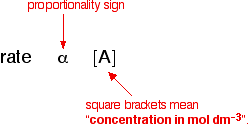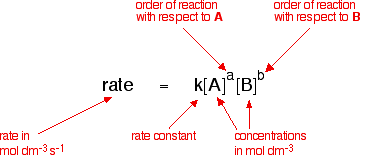Thủ Thuật Hướng dẫn When concentration of reactant is doubled the rate of reaction becomes 4 times the order of reaction is? 2022
Quý khách đang tìm kiếm từ khóa When concentration of reactant is doubled the rate of reaction becomes 4 times the order of reaction is? được Cập Nhật vào lúc : 2022-10-21 11:35:22 . Với phương châm chia sẻ Bí quyết Hướng dẫn trong nội dung bài viết một cách Chi Tiết 2022. Nếu sau khi Read Post vẫn ko hiểu thì hoàn toàn có thể lại phản hồi ở cuối bài để Mình lý giải và hướng dẫn lại nha.
ORDERS OF REACTION AND RATE EQUATIONS
Nội dung chính- When concentration of reactant is doubled the rate of reaction is 4 times then order of reaction?
- When the concentration of A is increased four times the order of reaction is?
- What happens to rate of reaction if concentration is doubled?
- Which reaction is second order reaction?
Changing the concentration of substances taking part in a reaction usually changes the rate of the reaction. A rate equation shows this effect mathematically. Orders of reaction are a part of the rate equation. This page introduces and explains the various terms you will need to know about.
Note: If you aren't sure about why changing concentration affects rates of reaction you might like to follow this link and come back to this page afterwards - either via the rates of reaction menu or by using the BACK button on your browser.Rate equations
Measuring a rate of reaction
There are several simple ways of measuring a reaction rate. For example, if a gas was being given off during a reaction, you could take some measurements and work out the volume being given off per second any particular time during the reaction.
A rate of 2 cm3 s-1 is obviously twice as fast as one of 1 cm3 s-1.
Note: Read cm3 s-1 as "cubic centimetres per second".However, for this more formal and mathematical look rates of reaction, the rate is usually measured by looking how fast the concentration of one of the reactants is falling any one time.
For example, suppose you had a reaction between two substances A and B. Assume that least one of them is in a form where it is sensible to measure its concentration - for example, in solution or as a gas.


For this reaction you could measure the rate of the reaction by finding out how fast the concentration of, say, A was falling per second.
You might, for example, find that the beginning of the reaction, its concentration was falling a rate of 0.0040 mol dm-3 s-1.
Note: Read mol dm-3 s-1 as "moles per cubic decimetre (or litre) per second".This means that every second the concentration of A was falling by 0.0040 moles per cubic decimetre. This rate will decrease during the reaction as A gets used up.
Summary
For the purposes of rate equations and orders of reaction, the rate of a reaction is measured in terms of how fast the concentration of one of the reactants is falling. Its units are mol dm-3 s-1.
Orders of reaction
I'm not going to define what order of reaction means straight away - I'm going to sneak up on it!
Orders of reaction are always found by doing experiments. You can't deduce anything about the order of a reaction just by looking the equation for the reaction.
So let's suppose that you have done some experiments to find out what happens to the rate of a reaction as the concentration of one of the reactants, A, changes. Some of the simple things that you might find are:
One possibility: The rate of reaction is proportional to the concentration of A
That means that if you double the concentration of A, the rate doubles as well. If you increase the concentration of A by a factor of 4, the rate goes up 4 times as well.
You can express this using symbols as:


Writing a formula in square brackets is a standard way of showing a concentration measured in moles per cubic decimetre (litre).
You can also write this by getting rid of the proportionality sign and introducing a constant, k.


Another possibility: The rate of reaction is proportional to the square of the concentration of A
This means that if you doubled the concentration of A, the rate would go up 4 times (22). If you tripled the concentration of A, the rate would increase 9 times (32). In symbol terms:


Generalising this
By doing experiments involving a reaction between A and B, you would find that the rate of the reaction was related to the concentrations of A and B in this way:

This is called the rate equation for the reaction.
The concentrations of A and B have to be raised to some power to show how they affect the rate of the reaction. These powers are called the orders of reaction with respect to A and B.
For UK A' level purposes, the orders of reaction you are likely to meet will be 0, 1 or 2. But other values are possible including fractional ones like 1.53, for example.
If the order of reaction with respect to A is 0 (zero), this means that the concentration of A doesn't affect the rate of reaction. Mathematically, any number raised to the power of zero (x0) is equal to 1. That means that that particular term disappears from the rate equation.
The overall order of the reaction is found by adding up the individual orders. For example, if the reaction is first order with respect to both A and B (a = 1 and b = 1), the overall order is 2. We call this an overall second order reaction.
Some examples
Each of these examples involves a reaction between A and B, and each rate equation comes from doing some experiments to find out how the concentrations of A and B affect the rate of reaction.
Example 1:


In this case, the order of reaction with respect to both A and B is 1. The overall order of reaction is 2 - found by adding up the individual orders.
Note: Where the order is 1 with respect to one of the reactants, the "1" isn't written into the equation. [A] means [A]1.Example 2:


This reaction is zero order with respect to A because the concentration of A doesn't affect the rate of the reaction. The order with respect to B is 2 - it's a second order reaction with respect to B. The reaction is also second order overall (because 0 + 2 = 2).
Example 3:


This reaction is first order with respect to A and zero order with respect to B, because the concentration of B doesn't affect the rate of the reaction. The reaction is first order overall (because 1 + 0 = 1).
What if you have some other number of reactants?
It doesn't matter how many reactants there are. The concentration of each reactant will occur in the rate equation, raised to some power. Those powers are the individual orders of reaction. The overall order of the reaction is found by adding them all up.
The rate constant
Surprisingly, the rate constant isn't actually a true constant! It varies, for example, if you change the temperature of the reaction, add a catalyst, or change the catalyst.
The rate constant is constant for a given reaction only if all you are changing is the concentration of the reactants. You will find more about the effect of temperature and catalysts on the rate constant on another page.
Note: If you want to follow up this further look rate constants you might like to follow this link. Alternatively, you could visit it later via the rates of reaction menu.Calculations involving orders of reaction
You will almost certainly have to be able to calculate orders of reaction and rate constants from given data or from your own experiments.
There are all sorts of ways of doing these sums, and it is important that you practice the methods that your syllabus wants. Check your syllabus and past exam papers to see what sort of examples you need to be able to work out.
Note: For UK A'level students, if you haven't got copies of your syllabus and past papers follow this link to find out how to get hold of them.Many text books make these sums look really difficult. In fact for A' level purposes, the calculations are usually fairly trivial. You will find them explained in detail in my chemistry calculations book.
Note: There are several reasons why there are very few calculations on this site. It is much easier to learn to do sums from a carefully organised book than from a website; I would be in breach of my contract with my publishers if I included material similar to what is in the book; and I need to sell a few books to generate some income!If you are interested in my
chemistry calculations book you might like to follow this link.
Where would you like to go now?
To a simple look how orders of reaction are related to reaction mechanisms . .
To the rates of reaction menu . . .
To the Physical Chemistry menu . . .
To Main Menu . . .

© Jim Clark 2002 (modified October 2013)
When concentration of reactant is doubled the rate of reaction is 4 times then order of reaction?
Solution : Since rate of reaction becomes four times on doubling concentration of reactant, it is second order reaction.When the concentration of A is increased four times the order of reaction is?
⇒n=12. It is found that the rate of reaction doubles when the concentration of A is increased by four times. What is the order of the reaction? It is found that the rate of reaction doubles when the concentration of A is increased by four times.What happens to rate of reaction if concentration is doubled?
The rate is proportional to the concentration of a reactant. When you double the concentration the rate doubles. The rate is proportional to the square of the concentration of a reactant.Which reaction is second order reaction?
Second order reactions can be defined as chemical reactions wherein the sum of the exponents in the corresponding rate law of the chemical reaction is equal to two. The rate of such a reaction can be written either as r = k[A]2, or as r = k[A][B]. Tải thêm tài liệu liên quan đến nội dung bài viết When concentration of reactant is doubled the rate of reaction becomes 4 times the order of reaction is? Reply
Reply
 3
3
 0
0
 Chia sẻ
Chia sẻ
Share Link Down When concentration of reactant is doubled the rate of reaction becomes 4 times the order of reaction is? miễn phí
Bạn vừa Read nội dung bài viết Với Một số hướng dẫn một cách rõ ràng hơn về Video When concentration of reactant is doubled the rate of reaction becomes 4 times the order of reaction is? tiên tiến và phát triển nhất và Share Link Cập nhật When concentration of reactant is doubled the rate of reaction becomes 4 times the order of reaction is? miễn phí.